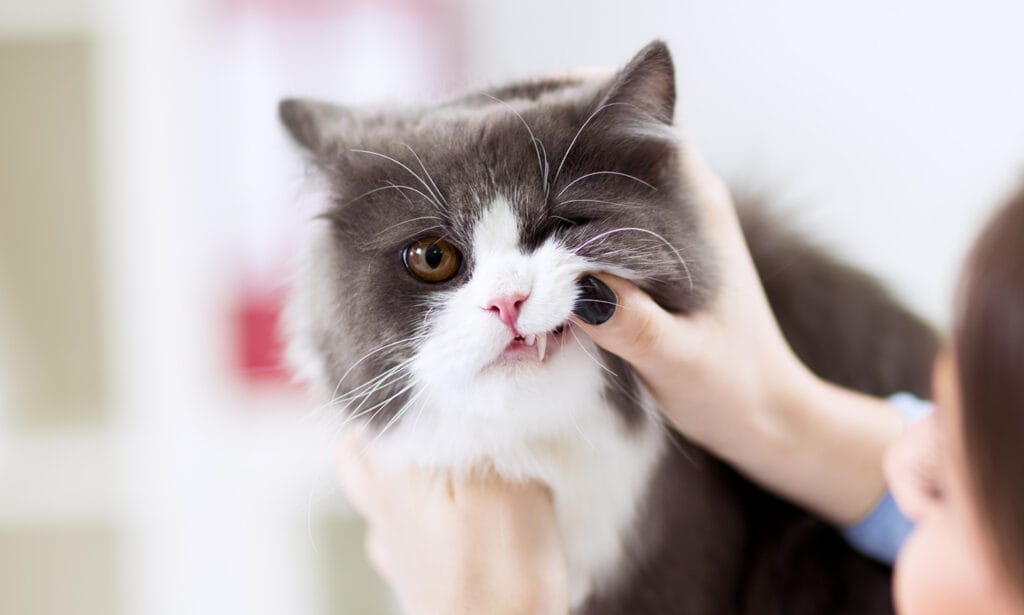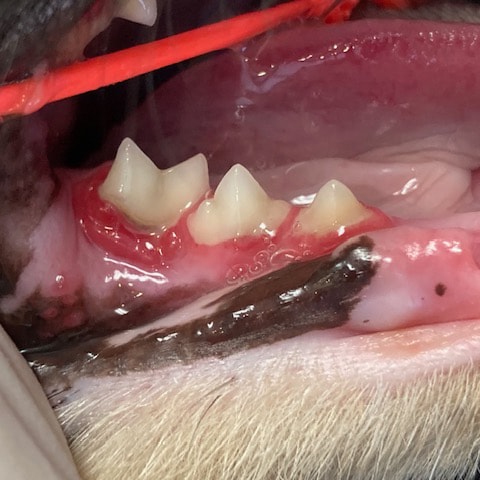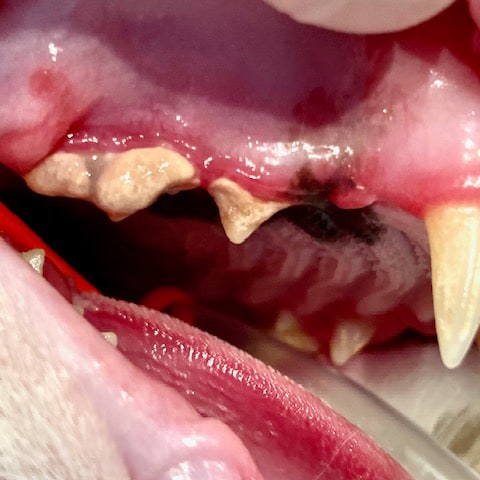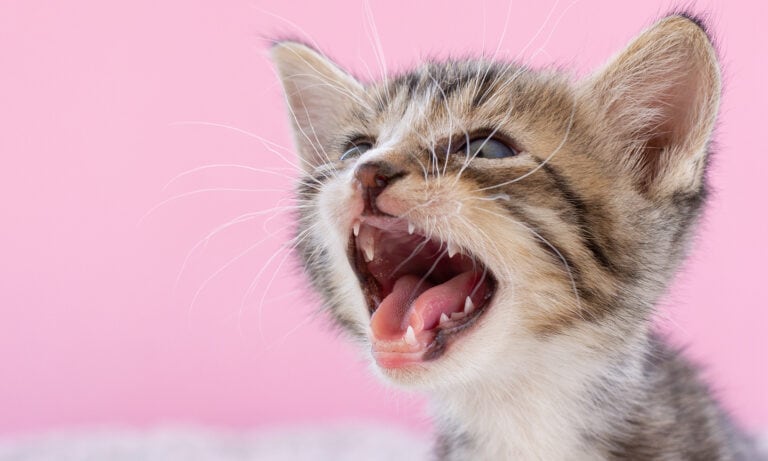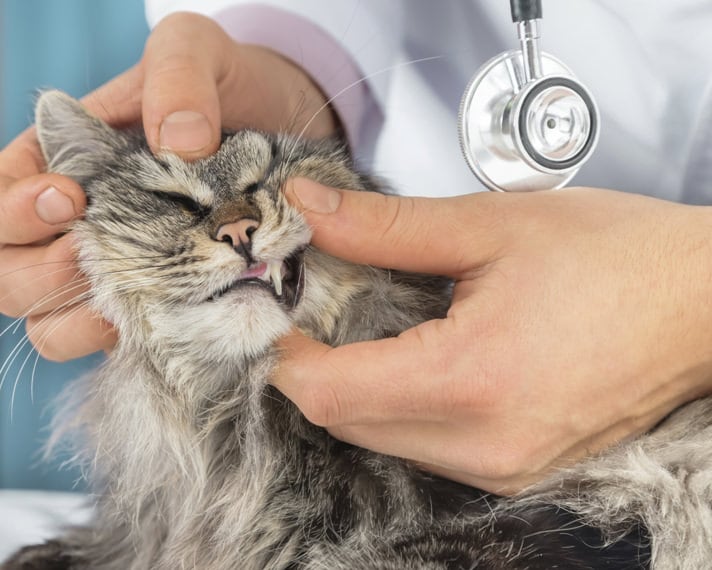A dentist has likely spoken to you about gingivitis during your own teeth cleaning appointments. But did you know cats can get gingivitis, too? And if left unchecked, it can lead to even more oral problems in your furry friend. (And no one wants that!)
We spoke with vet experts about everything you need to know about gingivitis in cats, including the signs and symptoms, causes, treatment, prevention and more.
Click to jump to each section:
What Is Gingivitis in Cats?
Simply put, gingivitis is inflammation of the gum tissue, or gingiva, surrounding the teeth. Gingivitis is the precursor to periodontal disease, a condition found in the vast majority of adult cats and dogs. In fact, according to the organization International Cat Care, 85 percent of cats aged 3 and older have some type of dental disease.
Not only is gingivitis one of the most common dental disease found in cats, but leads to periodontal disease, which is actually the most common disease, in general, for cats: Every cat is prone to developing periodontal disease, which is caused by gingivitis. But some purebred cats, such as Persians, British Shorthairs and Siamese, are more predisposed to develop it. Some cats will even develop gingivitis at a young age; this is called juvenile-onset gingivitis.
But is gingivitis contagious in cats? While the condition itself isn’t contagious, some causes of gingivitis can be contagious. We’ll discuss that in more detail later.
Cat Gingivitis Symptoms
Some key signs of gingivitis in cats can include:
- Redness and inflammation in the tissues around the teeth
- Swollen or enlarged gum tissue
- Receding or regressing gum tissue (when it has advanced to periodontal disease)
- Bleeding from the gum tissue
Keep in mind that not every symptom is seen in every case. Some cats can have mild signs, while others can have severe evidence of gingivitis.
As gingivitis worsens, it can progress to more advanced symptoms, including:
- Sore gums
- Halitosis (bad breath)
- Dropping food
- Slow eating
- Anorexia
- Weight loss
- Oral pain
- Pawing at the mouth
- Poor grooming habits
What Does Gingivitis Look Like?
At first, gingivitis can make the normally pink and healthy gum tissue appear a shade of darker pink or red. Sometimes, when gingivitis is early, you may only see a thin red line along the edge of the gum. But as the condition progresses and becomes more advanced, the gums may become red, swollen, inflamed and painful. Gingivitis will be found around one or more teeth.
Gingivitis can also cause bleeding when the tissues are manipulated. Even small acts such as chewing food can bring on mild bleeding.
Pictures of Gingivitis in Cats
Cat Gingivitis Stages
Essentially, gingivitis is a stage of periodontal disease. Specifically, it’s the first of four stages of periodontal disease.
Stage one of periodontal disease is gingivitis without loss of the supportive structures around the tooth, or the periodontium. Periodontal disease can be grouped as mild, moderate or severe. Sometimes this can be based on bleeding indexes, amount of recession of the teeth or enlargement of the gums and other factors.
If periodontal disease progresses to stages two, three and four (also called advanced periodontitis), there is more attachment loss around the tooth. When plaque (which causes gingivitis) and gingivitis edge below the gum line, this can lead to bone loss and loss of attachment of the gum tissue.
Confirm the stage of periodontal disease with your vet.
Cat Gingivitis Causes
What causes gingivitis in cats? Ahead, we’ll list these expert-guided catalysts that can bring on gingivitis. They include:
- An accumulation of plaque on the teeth: Plaque bacteria forms a slippery film on tooth surfaces. If not consistently cleaned off, the body’s immune system reacts to the bacteria by releasing inflammatory chemicals. This leads to inflammation.
- Feline chronic gingivostomatitis (FCGS): FCSG is a severe and chronic inflammation of cats’ gums that can be contagious.
- Viruses: Some viruses can also cause or contribute to gingivitis, and can be contagious among cats. These include feline leukemia virus (FeLV), feline immunodeficiency virus (FIV) and feline calicivirus (FCV).
- Eosinophilic granuloma complex (EGC): EGC, or inflammation found in cats’ skin, can cause gingivitis.
- Various immune-mediated conditions that result from an abnormal immune system response: Conditions can include autoimmune diseases such as FCGS and possibly inflammatory bowel disease.
- Infections: The respiratory infection feline calicivirus can cause gingivitis.
When to Go to the Veterinarian
Every cat should have an annual physical examination (or more frequent if needed) performed by a veterinarian, and this should include an oral exam. Your vet will determine if gingivitis is present, or if they suspect periodontitis (periodontal disease). Dental disease like gingivitis can be identified early if you take your cat in for regular checkups.
But let’s say your cat isn’t due to visit the vet for a while. Any time you notice gingivitis or evidence of redness or inflammation in the mouth, seek out your primary care veterinarian or a board-certified veterinary dentist to discuss treatment options.
Your cat should be examined if you see signs of oral pain, including:
- Redness or bleeding from the gums
- Halitosis
- Increased drooling
- Changes in appetite
- Dropping food
- Pawing at the mouth
- Swollen eyes, gums or cheeks
Cat Gingivitis Treatment
The good news about gingivitis is that it can be reversible.
If the gingivitis is caused solely by plaque...
Appropriate oral hygiene may be successful in controlling and eliminating gingivitis.
If the gingivitis is mild...
Regular brushing can do wonders. Veterinarians say brushing is the first step in reducing gingivitis for your cat, and ideally you’ll brush daily—or no fewer than three to four times per week. The brush used should have actual bristles to sweep below the gum line. The use of a pet-friendly toothpaste is a must, too. Stay away from human toothpastes, as many cats do not like the flavor; they contain too much fluoride and sodium; and many human toothpastes contain xylitol, which is not safe for pets.
If your cat isn’t amenable to regular brushings, schedule annual dental cleanings at least every 12 months. This can be performed by your primary care veterinarian or a board-certified veterinary dentist. Even if you brush your cat’s teeth, many cats do end up needing a professional cleaning to treat gingivitis down the line. A professional cleaning allows the vet to thoroughly clean the teeth above and below the gum line. They should also perform periodontal probing, and intraoral dental radiographs or X-rays to check for evidence of periodontitis and other problems.
If there is periodontitis...
Additional treatments may be necessary. Sometimes medications will be prescribed to help reduce or control gingivitis.
After a dental cleaning and evaluation, home care is needed to maintain your cat’s periodontal health. This typically means brushing every day. Your vet may also recommend other home treatments, like dental diets, dental treats and supplements.
Cat Gingivitis Treatment Cost
When it comes to all of the aforementioned gingivitis treatment options, the costs can vary quite a bit. That’s why it’s best to speak to your primary care veterinarian about what they charge or if they recommend seeking specialty care. Your vet can also discuss cost options.
The most cost-effective treatment is prevention. Brushing your cat’s teeth at an early age can help prevent problems and expenses later in life. A cat-appropriate toothbrush and toothpaste is relatively inexpensive. The cost of a professional dental cleaning can vary from several hundred dollars to over $1,000. This varies depending upon the region of the country, and the experience level of the staff or veterinarian.
It's also important to know who will be cleaning your cat’s teeth, monitoring anesthesia and what services are included in the price. Is it an assistant, a certified technician or a veterinarian performing these crucial tasks? Is it a general practice versus a specialty practice? Are pre-operative labs performed? What about imaging (radiographs or advanced imaging); IV catheter and fluids; pain management; and so on? All of these factors impact the bottom line and are key questions to ask your vet.
Cat Gingivitis Treatment at Home
At home, regular brushing is recommended. If that’s not possible, anesthetized annual cleanings with your primary care veterinarian or a board-certified veterinary dentist is ideal.
To augment your teeth-brushing efforts at home, vets recommend 1-TetraDecanol Complex (1-TDC), a fatty acid oil supplement that can help reduce inflammation and support healthy gums. Generally, products accepted by the Veterinary Oral Health Council (VOHC) are best to use at home. For instance, dental diets and treats approved by the VOHC have been independently reviewed to make sure the product reduces plaque and/or tartar.
Maybe you’ve been browsing Pinterest and discovered a recommendation to use coconut oil for cat gingivitis, advising you to rub coconut oil directly on their gums. Overall, our experts tend to shy away from coconut oil, and some of the more natural or homeopathic treatments because they often lack solid studies. Coconut oil, for example, has some research on the human side, but there are only anecdotes or limited clinical research of oral benefits in veterinary patients.
How to Prevent Gingivitis in Cats
Gingivitis in your cat’s mouth can be prevented. These preventative measures include:
- Brushing regularly
- Feeding a vet-approved dental diet if your cat does not have other health concerns
- Feeding treats accepted by the VOHC
- Regular professional dental cleanings
The best products you can purchase to prevent gingivitis in your cat come with the seal of the VOHC. These products go through a rigorous process and are proven to decrease plaque and calculus (or hardened tartar buildup) on the teeth, which reduces or eliminates gingivitis.
Additionally, cats tend to love Greenies dental treats, which can prevent plaque from forming on their teeth.
More on cat teeth:
Share:
